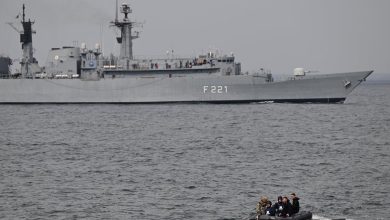Guam missile defense office awaits funds to build layered architecture

The Pentagon’s joint program office for the missile defense of Guam is waiting on fiscal 2024 funding to be reprogrammed from elsewhere in the budget to help pay for its efforts to build an architecture to defend the key U.S. territory in the Pacific.
But that doesn’t mean a lot of work isn’t already underway to design and plan architecture critical to defending the strategic island from potential air and missile attacks from adversaries like China.
The project office, which is run by the Army’s Rapid Capabilities and Critical Technologies Office boss Lt. Gen. Robert Rasch, is operating with eight people “working really, really hard establishing the network of communications” between defense players, including the Missile Defense Agency, which has spent the last several years developing the initial architecture, Rasch said at a July 30 Center for Strategic and International Studies event in Washington.
The office is waiting on a reprogramming action so it can start manning beyond the eight staff currently devoted to the effort, Rasch added. The JPO for Guam was stood up in February 2024 after the FY24 budget had been established.
Key decisions remain on which agency or services will own and control what equipment as part of the architecture. Additionally, it remains to be seen how the capabilities designated for the architecture will come together, but a requirements document is in staffing now, Rasch said.
Those requirements and plans will evolve as the office continues to work with U.S. Indo-Pacific Command on how it wants to use the system to fight, as well as what that means for integration between various elements of the architecture.
The Missile Defense Agency and the Army sought a combined $1.5 billion in the FY24 budget to begin preparing the island by moving assets into place and integrating capabilities. The Pentagon also designated the Army as the lead service overseeing the acquisition and plan of defending Guam.
Guam is an island of nearly 170,000 people that sits in a vulnerable position — it is closer to Beijing than it is to Hawaii. The island plays host to a significant amount of U.S. combat power and would therefore be an attractive target for China in the event of a war in the Taiwan Strait.
While the MDA indicated it planned to begin delivering additional capability beyond what is already on Guam — and would incrementally supplement that in subsequent years — what is currently on the island “hasn’t fundamentally changed,” Rasch said.
“The phasing of capabilities as they come in, those are going to deliver on the schedule that the services and the agency are delivering on. I don’t have any magic resource dust to put [the Lower Tier Air and Missile Defense Systems] to the left two years or [the Integrated Battle Command System],” he told Defense News at the event.
“We’re managing the really massive, integrated master schedule of all these individual programs and making sure the right pieces are coming at the right time. And, by the way, there is a whole layer of [military construction] activities that truly isn’t even starting until we finish the design reviews.”
Rasch emphasized that, over time, the toughest part will be ensuring all of the architecture’s capabilities work together and that all services are able to operate using a single air picture.
The Army is planning to incorporate its legacy Patriot air and missile defense system as well as its in-development Lower Tier Air and Missile Defense Sensor that will replace Patriot’s radar. It will also bring its newly fielded Mid-Range Capability missile launcher and its Indirect Fire Protection Capability launchers, still in the prototype phase, when ready.
Additionally, the service plans to tie into the architecture its new IBCS command and control system, which was approved for full-rate production in FY23.
The Navy, meanwhile, is set to provide technology and capability from its Aegis weapon system, and MDA will provide high-end, solid-state, mobile AN/TPY-6 radars — new sensors that use technology from the Long Range Discrimination Radar in Clear Space Force Station, Alaska.
Establishing the architecture in a layered way means the services all need to develop software for individual control systems, like IBCS, with Guam in mind, Brig. Gen. Frank Lozano, program executive officer for missiles and space, said during the same event.
In a scenario in which threats vary widely and are overwhelming in number, “you have to have a battle management, fire control system capable of adjusting on the fly based on how threats are presented,” he said. “And then, in real-time, making decisions, teeing up decisions for operators to make so that they’re survivable and they win in that defensive scenario.”
Jen Judson is an award-winning journalist covering land warfare for Defense News. She has also worked for Politico and Inside Defense. She holds a Master of Science degree in journalism from Boston University and a Bachelor of Arts degree from Kenyon College.







